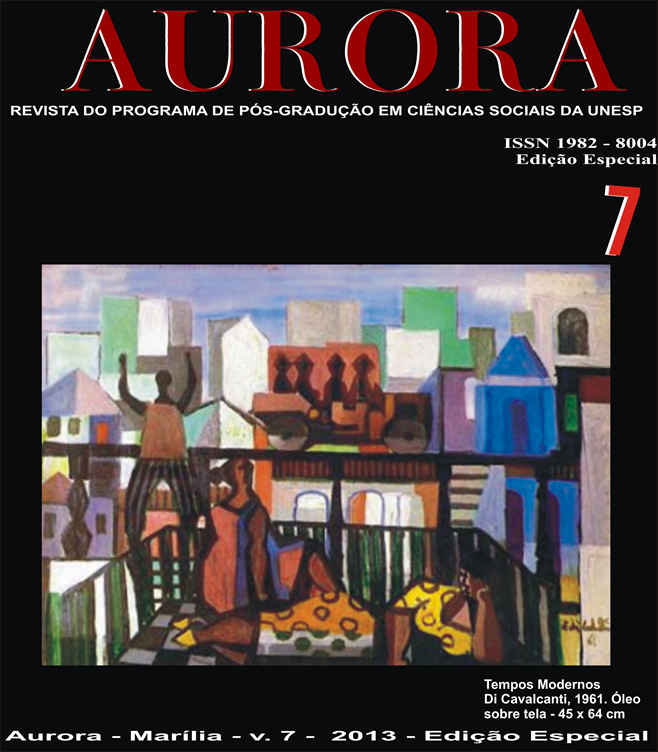Right to work no child and adolescent development as assumption mental and physical
DOI:
https://doi.org/10.36311/1982-8004.2013.v7n0.3419Keywords:
Child, Teenager, Full Protection, Child Labor, Right to LeisureAbstract
The present study aimed at the presentation of the historical aspects of the Rights of Children and Adolescents at the international and national levels with an emphasis on child labor as opposed to the right to leisure. Addressed the influence of evolutionary process obtained by international law on the right of the lowest in Brazil, bringing to the discussion their main characteristics and their legislation, proposing ways to secure these rights, on the principle of full protection especially in the development phase and psychological child's physical and adolescents. In Brazil, found that children and adolescents are in the labor market, by necessity or for not having another option to use the free time. It was found that at the present time, the work of children and adolescents in Brazil presents itself unworthy and inhuman, because of various factors. It was found that the effectiveness of the law does not work for children and adolescents is the duty of the family, society and the state, they must act so that the appreciation of the study of the intellectual and physical development, so that the practice of activities fun and uncommitted part of everyday life.
Downloads
References
ARIÈS, Philippe. História Social da Criança e da Família. 2. ed. Rio de Janeiro: Afiliada, 1981.
BRASIL. Constituição (1988). Constituição da República Federativa do Brasil: promulgada em 5 de outubro de 1988. Organização do texto: Juarez de Oliveira. 27. ed. São Paulo: Saraiva, 2003 (Série Legislação Brasileira).
BRASIL. Lei no 8.069, de 13 de julho de 1990. Dispõe sobre o Estatuto da Criança e do Adolescente e dá outras providências. Diário Oficial [da] União, Poder Executivo, Brasília, DF, 16 de jul. 1990.
BRASIL. CLT – Consolidação das Leis do Trabalho. 28. ed. São Paulo: Saraiva, 2003 (Série Legislação Brasileira).
BOBBIO, Norberto. A Era do Direito. 9. ed. Rio de Janeiro: Elsevier, 2004.
CRUZ NETO, Otávio; MOREIRA, Marcelo R. Trabalho infanto-juvenil: motivações, aspectos legais e repercussão social. Cad. Saúde Pública v.14 n. 2. Rio de Janeiro, abr./jun. 1998. Disponívelem:http://www.scielo.br/scielo.php?script=sci_arttext&pid=S0102311X1998000200029&ln g=pt&nrm=iso Acesso em: 13 mai. 2013.
GOULART, Marcelo Pedroso. A convenção sobre a idade mínima e o Direito Brasileiro. In: CORRÊA, B. Lélio; VIDOTTI, J. Tárcio (Org). Trabalho Infantil e Direitos Humanos. São Paulo: LTr, 2005.
ISHIDA. Valter Kenji. Estatuto da Criança e do Adolescente: Doutrina e Jurisprudência. São Paulo: Atlas, 1998.
KRAMER, Sonia. A política do pré-escolar no Brasil: A arte do disfarce. Rio de Janeiro: Paz e Terra, 1990.
MENDES, Moacyr Pereira. A doutrina da proteção integral da criança e do adolescente frente à lei 8.069/89. Dissertação de Mestrado. Puc/SP, 2006.
MEAD, M. Adolescencia y cultura en Samoa. Buenos Aires: Paidós, 1951.
PEREIRA, Tânia da Silva. Direito da Criança e do Adolescente: uma proposta interdisciplinar. Rio de Janeiro: Renovar, 1996.
SILVA, De Plácido e. Vocabulário Jurídico. Rio de Janeiro: Forense, 1987. v. 1, p. 145 e 165.
SILVA, Edid R. A. O direito à convivência familiar e comunitária: os abrigos para crianças e adolescentes no Brasil. Brasília: IPEA/CONANDA, 2004.
SILVA, José Afonso da. Curso de Direito Constitucional Positivo. 16. ed. São Paulo: Malheiros, Ed., 1999.
Downloads
Published
Issue
Section
License
Copyright (c) 2013 Marcela Andresa Semeghini Pereira, Lourival José de Oliveira

This work is licensed under a Creative Commons Attribution 4.0 International License.
Open Access Journal Policy
Authors retain copyright over the published article, and Revista Aurora holds the right of first publication. The Journal adopts the Creative Commons Attribution (CC BY) 4.0 International license, which is used internationally by leading open access journals and publishers. This license allows others to remix, adapt, and build upon the published work, while giving appropriate credit to the original authors and the initial publication in this journal. Authors are permitted to enter into separate additional contracts for the non-exclusive distribution of the version of the work published in this journal (e.g., to publish in an institutional repository, on a personal website, to publish a translation, or as a book chapter), with acknowledgment of the authorship and initial publication in this journal.










